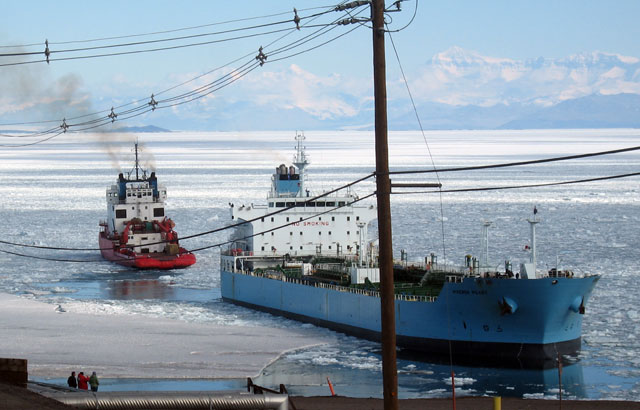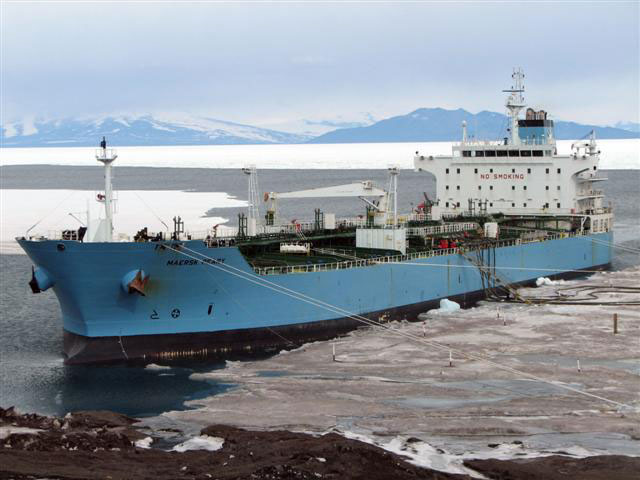Page 2/2 - Posted March 2, 2012
Cargo operation a key link in science supportDespite working on a much smaller pier — the ice version is nearly twice the size of a football field at 100,000 square feet versus only 7,600 square feet for the MCS — and having a cargo ship with only two cranes instead of three, as in years past, the operation moved faster than anticipated. “What we learned from the smaller surface area for landing the cargo is that we can move cargo effectively in a smaller area than the ice pier,” Burnett said. “The size of the ice pier is driven by the size of the vessel for mooring purposes. The other thing we developed from this adversity is another means to moor the ship without relying on the pier as a fender to the shoreline.” Also, instead of using flatbed trucks to haul cargo containers to and from the ship, personnel employed heavy-lift fork trucks while on the pier. That shaved off about five minutes per lift over the trucks, Burnett said, eventually saving more than two days in charter costs for the vessel. “At this point, we are through all of the risky stuff for the program. If that cargo had not gotten down, that would have started another big problem of how you get the supplies in. We would have had to airlift it in at great expense,” Sheppard said. The operation also includes reloading the ship with waste, recyclables and other materials no longer needed on the Ice. The ship also carries back scientific samples, such as ice cores and rocks, including meteorites, which researchers collected during the previous months. “The reason we go to Antarctica is to do the science, so it’s important for the ship to get in this year. We can keep the people alive and keep the station running, but the science would have suffered,” Sheppard said. The research was actually in jeopardy before the 2011-12 season even began for another issue related to ice and ships. The USAP requires the services of an icebreaker each year to cut a channel through the annual sea ice that fronts McMurdo Station. The channel allows the cargo vessel and a fuel ship, escorted by the icebreaker, to reach the station. For decades, U.S. Coast Guard For the past several years, the NSF had contracted with the Swedish government for the icebreaker Oden 
Photo Credit: Corey Chan
The Russian icebreaker VLADIMIR IGNATYUK, left, escorts the fuel tanker to McMurdo Station.
It wasn’t until late August that the NSF chartered the Russian icebreaker Vladimir Ignatyuk for the job of breaking ice to McMurdo, even as the first flights were arriving. [See previous article — Breaking news: NSF secures Russian icebreaker to help resupply McMurdo for 2011-12 season.] “We’ve seen every one of our Achilles’ heels this year — those critical links in the logistics chain have been challenged, except for airlift,” Sheppard said. “Airlift went without a hitch this year, and really was a great gap filler.” Airlift in this case involves the U.S. Air Force C-17, which flies between Christchurch, New Zealand, and McMurdo, and the smaller ski-equipped LC-130, which supports South Pole Station and deep-field camps. The Vladimir Ignatyuk arrived at McMurdo in late January, followed by the MSC tanker Maersk Peary, which unloaded about seven million gallons of fuel. The icebreaker’s job to break a channel and clear the ice from Winter Quarters Bay was made easier by ample open water in McMurdo Sound. That was also a bonus for constructing the Army’s deployable pier. “We’re fortunate this year that we have a lot of open water that normally isn’t there,” Sheppard said. “It was a struggle to the end, but it’s going out on a good note.”Back 1 2 |



For USAP Participants |
For The Public |
For Researchers and EducatorsContact UsNational Science FoundationOffice of Polar Programs Geosciences Directorate 2415 Eisenhower Avenue, Suite W7100 Alexandria, VA 22314 Sign up for the NSF Office of Polar Programs newsletter and events. Feedback Form |



